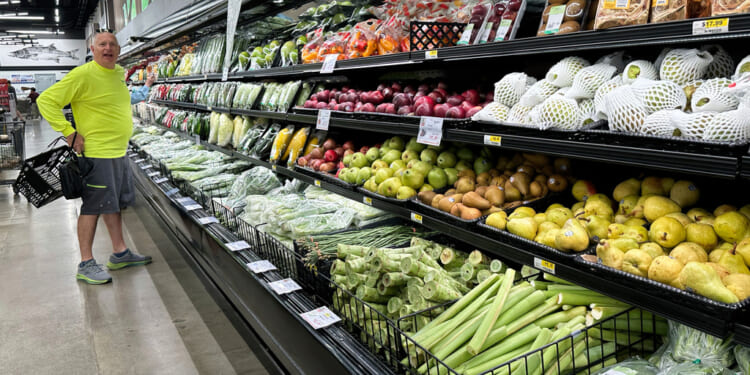The headlines say inflation is down, and politicians call it progress. But for most Americans, those headlines don’t make it past the checkout line. Prices may not be climbing as fast, but they never came back down. Grocery inflation cooled only after household budgets were scorched.
Before COVID-19, grocery prices were stable. In 2019, “food at home” inflation was just 0.7%. Then the pandemic hit: Empty shelves, labor shortages, and higher shipping costs pushed prices up 3.9% in 2020, 6.5% in 2021, and a staggering 11.4% in 2022 — the sharpest climb in four decades. Prices have since “cooled” to around 2% or 3% growth, but they’re cooling on top of a mountain. A $100 basket of groceries in 2019 now costs $125 to $130.
Gasoline followed the same arc — $2.60 a gallon in 2019, peaking near $5 in 2022, and now around $3.05. Energy prices dropped from panic highs but never returned to normal. And because every stage of the food chain relies on fuel and electricity, persistent energy costs guarantee persistent grocery costs.
WHAT CAN TRUMP DO TO HELP COST OF LIVING BEFORE MIDTERM ELECTIONS?
COVID-19 didn’t just raise prices; it rewired how food is made and moved. Fertilizer costs doubled after global shortages and trade duties. Tariffs on tin-plate steel added 10% to 15% to the cost of canned goods. Farm worker shortages and higher trucking costs drove up harvest and transport prices. Energy, the backbone of the system, magnified them all. When every step from fertilizer to freezer depends on fuel, the math doesn’t favor lower prices.
Energy is the single biggest invisible tax on every meal. Fertilizer production runs on natural gas, refrigeration on electricity, and trucks, trains, and ships on diesel. When energy prices spike, so does everything they touch — long before a product reaches the shelf. That’s why stabilizing energy supply is the surest path to stabilizing food prices.
Predictable energy doesn’t have to mean picking sides between fossil fuels and renewables. What households need is reliability and balance. Expanding domestic refining capacity, clearing bottlenecks in pipeline construction, and streamlining permits for new generation — including natural gas, solar, and nuclear — would reduce volatility and ease the cost of logistics. Even small drops in fuel and power prices ripple through farms, factories, and freezers. A truck that burns less diesel, a processing plant that runs more efficiently, and a distribution center that doesn’t face blackouts each shave pennies off the items in your cart.
Artificial intelligence is the newest variable in this equation. The rapid build-out of AI data centers is driving up power demand nationwide, especially in states with heavy server-farm construction. Those facilities consume vast amounts of electricity, often sourced from the same grids that power refrigerators and keep factories running. Unless generation expands in step with demand, this digital expansion will keep upward pressure on energy prices — and, by extension, on groceries. Managing that balance will determine whether AI becomes another inflation driver or a catalyst for infrastructure investment that benefits everyone.
The post-COVID-19 costs became the new baseline. Once supply chains had adapted, there was little incentive to roll prices back. Companies moved on. Families didn’t.
Washington talks in 12-month increments because that’s how inflation is reported. Year-over-year numbers sound tidy on cable news, but they hide the compounding reality. A 2% increase on top of a 25% surge isn’t progress.
Both parties have played the game. The Inflation Reduction Act was advertised as a cure, but even the Congressional Budget Office called its effect on inflation “negligible.” It funded climate and healthcare projects, not cheaper groceries. While Washington celebrated a statistical victory, Americans paid a quiet tax on food and fuel.
Real fixes aren’t glamorous, but they work. Ending phosphate fertilizer duties and restoring domestic nitrogen production could lower grain and produce costs by several percentage points. Reforming tariffs on tin-plate steel would cut the price of canned goods nearly 10%. Streamlining farm worker visas and improving refrigerated transport would reduce spoilage and waste. Enforcing competition laws among big food processors could restrain price markups. Encouraging regional food hubs that shorten supply chains would save both energy and dollars. None of these steps make for catchy talking points, but together they could reclaim 5% to 10%of the post-COVID-19 surge in food prices over time.
TRUMP TICKING OFF CAMPAIGN PROMISES, BUT PESKY ISSUE OF INFLATION STILL ELUDES HIM
Even if every reform worked perfectly, families would still be left paying about 15% more for groceries than before the pandemic. That’s the lasting tax of compound inflation. But every dollar clawed back is a dollar that stays in a household budget instead of disappearing into overhead. And unlike stimulus checks or slogans, these fixes go after the cause rather than the symptom.
Families don’t buy Consumer Price Indexes. They buy dinner, gas, and a little peace of mind. Until Washington stops celebrating lower inflation and starts pursuing lower prices, the great grocery illusion will persist — cooling the thermometer without curing the fever.
Joe Palaggi is a writer and researcher focused on household economics and public policy; his recent work has appeared in the Washington Examiner, RealClearPolicy, and The Hill.
















